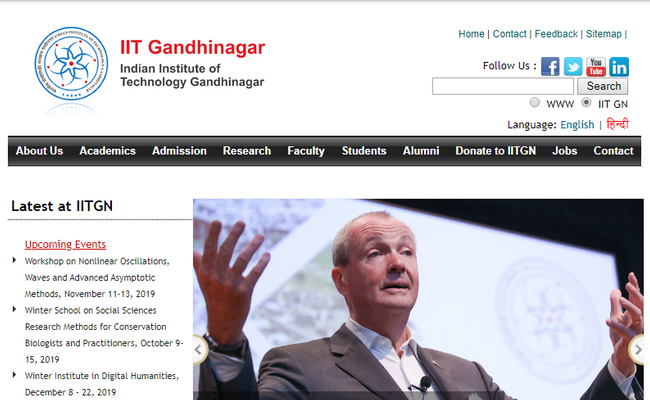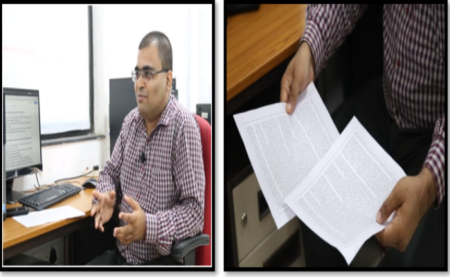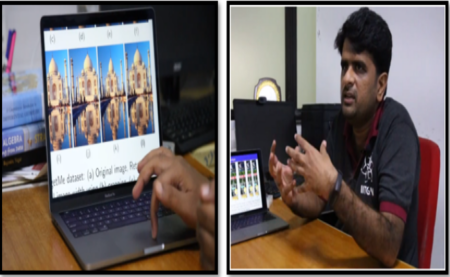
“Science is part of the reality of living; it is the what, the how, and the why of everything in our experience.” – Rachel Carson, American marine biologist, author, and conservationist
Hello Friends! I hope you had an awesome Diwali. Today, I am back with some more interesting research stories from IIT Gandhinagar for you. Similar to the first part of this article, these tales focus on the communication of interdisciplinary, collaborative researches in different areas at this Institute with a public-friendly approach.
So let’s begin!
The first story is that of the fingerprinting of electronic printers. Were you aware that printers can also have unique fingerprints like us? Dr. Nitin Khanna (IITGN professor in Electrical Engineering) and Sharad Joshi (his Ph.D. student) have developed a novel Printer Specific Local Text Descriptor (PSLTD). This research can potentially be beneficial while authenticating a printed piece of information or copyright ownership. It could also be utilized to solve fraudulent crime investigations in the future. Data that does not come from an authentic source undergoes specific changes while it gets printed. This study focuses on addressing the traceability of such content.

When we talk about people, ID cards were a method of identification earlier. Users were given a new (additional – extrinsic) characteristic feature in the form of IDs, and hence it was called passive identification. Now-a-days, biometric scanning has replaced these cards. People have started using techniques like fingerprinting – something which is internal and unique to every person. The researchers plan to apply the same process with electronic printers – the purpose is to have accurate identification of the authenticity of documents. This technique allows us to distinguish between visually the same content printed from two different models of different as well as the same brands!
It’s working mechanism? After scanning and extracting the characters from printed documents, the process takes certain statistical features from each letter (alphabet), based on the local texture of the content. In this way, we get a descriptor from each alphabet. The next step, known as average pooling, gives a single descriptor for an individual printer, serving as a unique signature. It is beneficial for the identification process. The most significant progress of this research is its approach independency of the characters and types of fonts used. Also, the printers would not require any changes or additions in them to utilize this technique. Lastly, it does not require any sophisticated machinery for its operation.
In the future, an essential requirement is the testing of this mechanism on a large scale. Other challenges include updating it to adapt itself to diverse languages (currently, it identifies the English language only), the ability to differentiate between font sizes. Prof. Nitin Khanna’s lab is also working towards replacing the scanners in this technique, with smartphones. It would promote the ease of usability among people.
In today’s world, we face the problem of lousy image cropping or resizing frequently. In such cases, either the picture gets blurred, or its proportions get messed up! Now, for a critical situation, such as in a legal document, it becomes essential to preserve the vital features and geometric consistency of this image – this is what our second research story is all about. Dr. Shanmuganathan Raman (IITGN professor in Electrical Engineering) and Diptiben Patel (his Ph.D. student) have proposed a method that prevents image deformation on different screens, an essential problem for 3D visualization. This technique functions in a more efficient manner as compared to the existing methods.

It is an artificial intelligence-based content-aware image retargeting technique that preserves the essential contextual information of a picture, giving a proportionate and blur-free image according to different display sizes! It is about how one can adapt multimedia content (objects and texts) to different target screens and electronic printers, with a variety of screen-resolutions and aspect-ratios. The goal is to rescale the picture correctly, without compromising on its clear visibility.
In a simple language, this mechanism protects only the necessary information and removes the unimportant details, leading to an effective rescaling of the image. The first discrete method on content-aware image retargeting, seam carving, generates horizontal or vertical curves (seams). It tracks down a seam having the least important information (minimum energy level) and removes it. This process requires training the involved algorithm (a procedure to solve a logical problem), to distinguish between necessary and trivial details. This study involves developing improved algorithms for this purpose.
Rather than the conventional system of deleting one seam at a time, this method tries to remove many unimportant curves at the same time (accelerated seam carving). Also, it is the first of its kind to address safeguarding reflection scene symmetry and scene text.
It resizes different objects present in the same picture simultaneously while successfully preserving the intrinsic geometry between them. The various depth levels of these interrelated objects remain protected, promoting sounder 3D visualization. In the future, this technique needs to be tested on videos to understand its real-time efficacy. There is a need for an improved real-time algorithm for a completely seamless experience. The process needs to be accelerated enough to minimize the time required for its completion. For this, some operations should run parallelly, and solutions about the same need to be found out. Eventually, these improvements would pave the way for the commercial utilization of this technique.
So, folks, this was all for today! I will soon be returning with another season of these educative and engaging tales – research stories 2.0 @ IITGN, progressing in my efforts to communicate science to the general public effectively. Stay tuned!
“Great communication begins with connection.” – Oprah Winfrey, American media executive, actress, talk show host, television producer and philanthropist
